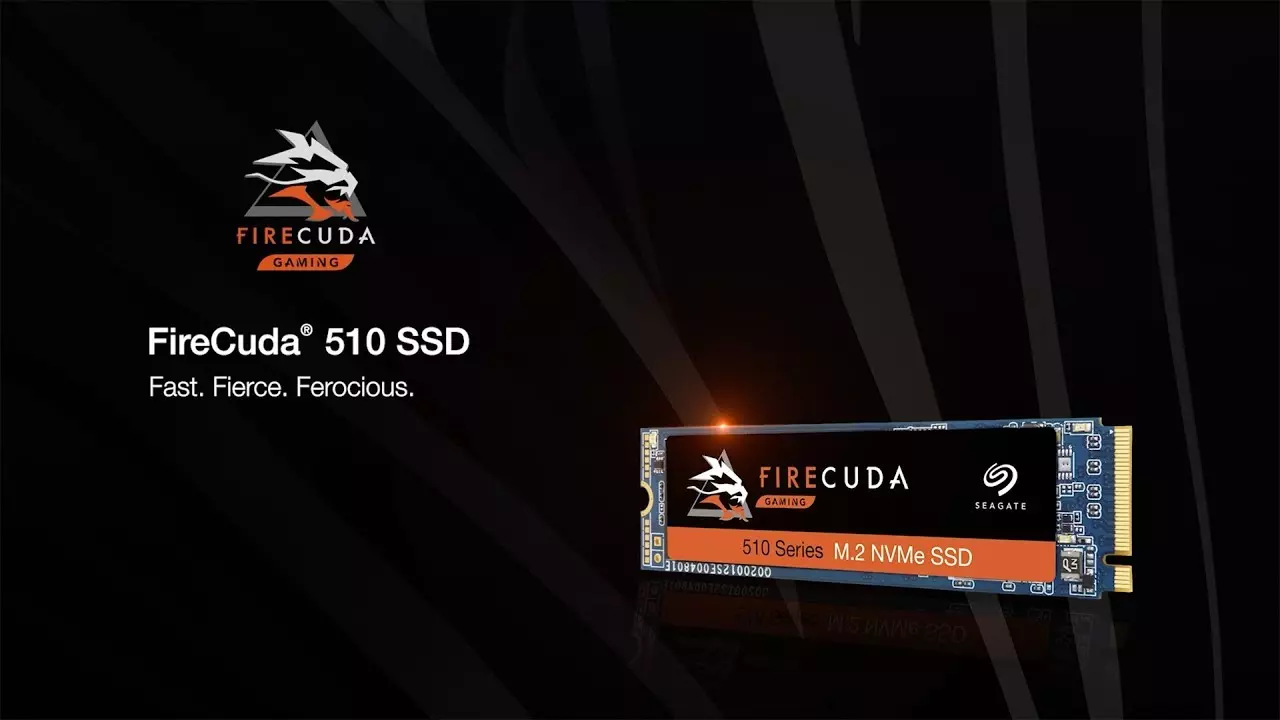Can Seagate translate its hard disk success to the demanding NVMe SSD market?
Seagate has been transforming its business of late, with the storage firm making inroads into the SSD market – and the Cupertino-based company has just released two new drives.
It’s no surprise that Seagate is moving in this direction. The firm may be better known for its hard disks, but the market for platter-based storage is shrinking – while SSDs are getting cheaper, larger and faster.
Seagate’s first SSDs were modest SATA-based drives. Now, though, the company has been more ambitious, with new drives that exploit the full potential of the faster NVMe connection.
The FireCuda 510

The more ambitious of the two new drives is the FireCuda 510. That brand isn’t as well-known as the BarraCuda name, but it’s used for more potent products designed for systems where more performance can make a big difference – like in gaming rigs, workstations and machines designed for creative tasks.
Because it’s designed for creative work, games and situations where large files are routinely used, the FireCuda 510 is available in 1TB and 2TB capacities – which makes these drives far more spacious than the mainstream BarraCuda drives.
The 1TB FireCuda costs around £200 and lines up against the Samsung 970 EVO Plus, which costs around £15 more for a 1TB drive. Samsung hasn’t released a 2TB version of the EVO Plus – it’s coming, but you’ll have to wait. That gives the 2TB Seagate free reign in this portion of the market.
The FireCuda’s increased capacity doesn’t just mean you’ve got more storage space – it’s also one of the main reasons why this drive can deliver better speeds, especially when compared to the new BarraCuda drives.
The FireCuda’s higher capacities mean that more memory chips are needed to build these SSDs – which means that there are more chips for the controller to address simultaneously. The controller being able to access more chips at the same time means that more data is being moved around concurrently – which means, naturally, that there are more opportunities for speeds to improve.
This has always been the case, but individual flash chips are now routinely 256GB or 512GB in size – which means the issue is exacerbated. After all, it’s no good having a controller that can handle loads of memory chips in parallel – but installing it on an SSD with only one memory chip.
What’s it made of?
The FireCuda uses a Phison PS5012-E12 controller, which is the same chip as the mainstream BarraCuda drives. It’s the most powerful controller that Phison produces in its E-branded range, which means it can handle eight different NAND channels – handy for a FireCuda drive which uses multiple memory chips to deliver its capacity, but wasted on a BarraCuda that may only need one or two memory chips.
Samsung’s drive use the familiar Phoenix controller, which is unchanged from the last generation of 970 EVO drives.
The two Seagate drives also use the same kind of memory – Toshiba-made, 64-layer 3D TLC NAND. That’s broadly in line with many consumer drives, but this is one area where Samsung has pushed forward. Its new 970 EVO Plus products use 96-layer chips that deliver faster transfer speeds.
How fast?
The FireCuda’s higher capacity makes sense for gaming and creative machines, and these drives also have far better endurance ratings than the BarraCuda products – no surprise for a drive designed for work. The 1TB and 2TB FireCuda products are rated for 912TB and 1,825TB of writes respectively – while the 256GB and 512GB BarraCuda drives sit at 140TB and 280TB of writes.
The FireCuda has good endurance levels when compared to Samsung’s drives, too. The 1TB 970 EVO Plus has an endurance rating of 600TB, while the eventual 2TB Samsung will top out at 1,200TB.
The FireCuda drives have the usual TRIM and SMART support, and they have a five-year warranty. In all of those areas they match Samsung. The Seagate uses the normal 2280 form factor, which means it’ll fit into virtually any laptop or motherboard with an M.2 connector.
In a few peripheral departments the FireCuda does fall behind. Its 5.4W power draw is a tiny bit higher than Samsung’s drives, and the Seagate has no heat-dissipating copper – unlike Samsung. The FireCuda also has no TCG Opal encryption, while the Samsung drives support this feature.
The BarraCuda 510

The BarraCuda 510 drives are Seagate’s new mainstream products, which is why they use the brand that’s adorned the firm’s consumer hard disks for so many years.
The two BarraCuda SSDs arrive with capacities of 256GB and 512GB. Obviously, neither of those can compete with the capacities of the FireCuda drives, but both are fine for installing a copy of Windows 10 alongside key games and applications.
The BarraCuda drives have poorer endurance ratings, with write levels of 140TB and 280TB – miles behind the FireCuda products. Those endurance ratings are behind equivalent Samsung 970 Evo Plus drives, too – the 250GB and 500GB Samsung drives have 150TB and 300TB endurance levels.
Still, Seagate’s mainstream drives compete well on price. The 256GB and 512GB Barracudas will cost around £60 and £100 – about ten pounds cheaper than Samsung’s offerings.
What’s inside?
The lower capacities mean that the BarraCuda drives are only built from one or two flash chips, which limits how much data the Phison PS5012-E12 controller can shift at once. That, naturally, will make these drives slower than the FireCuda products.
The smaller capacities and lower endurance ratings mean that the BarraCuda drives will be less effective in demanding situations, but they’re certainly not going to be slow or unreliable. While those FireCuda parts are better for creative work and for large games collections, the BarraCuda products will still get the job done with reasonable speed.
Elsewhere the Barracuda drives have TRIM and SMART features, like just every other drive mentioned here. They’re also available with TCG Opal encryption, which matches Samsung and helps this drive go one better than the FireCuda.
The Barracuda’s five-year warranty matches Samsung’s drives, and the Barracuda draws 5W of power – another area that matches the 970 Evo Plus.
On the outside, Seagate’s mainstream looks dull, with a tiny, plain sticker and no heat-dissipating copper.
Performance
Both of the Seagate drives are decent performers, although it’s understandable that they rarely match the speeds delivered by the more expensive Samsung drives and their 96-layer memory.
The 2TB FireCuda offers a better balance of performance than the 512GB Barracuda, which is faster in some situations but much slower in others.
CrystalDiskMark Tests
In CrystalDiskMark the FireCuda returned sequential read and write speeds of 3,417MB/s and 3,027MB/s, while the Barracuda ran at 3,452MB/s and 2,292MB/s. The Barracuda’s read score may be a tiny bit better than the FireCuda, but its write score is miles behind – which is why we prefer the FireCuda for all-round performance.
The FireCuda’s balanced sequential pace is important for creative work, where huge files demand consistent read and write pace. However, the FireCuda wasn’t as good in the rest of CrystalDiskMark’s tests, which evaluate random file performance with different levels of parallelism and queuing.
In those tests, the Barracuda was usually quicker, which makes sense for a mainstream drive where nimble performance with small files is valuable.
Samsung’s 1TB and 500GB 970 EVO Plus drives were almost always faster in CrystalDiskMark. The 1TB drive delivered sequential read and write speeds of 3,542MB/s and 3,341MB/s, with the 500GB drive returning speeds of 3,553MB/s and 3,278MB/s. The FireCuda is close behind, although the Barracuda’s write pace remains a long way back.
The two Samsung drives continued to lead the way in the rest of the CrystalDiskMark tests, with the 1TB drive proving fastest. That’s hardly a surprise – it’s the most expensive SSD we’ve tested here.
Atto Disk Tests
The Atto disk benchmark tests an SSD’s read and write abilities with a huge number of different file sizes, starting with tiny 1kb files and working up to 64MB. That’s important, because SSDs are always moving files at different sizes.
The FireCuda drive quickly accelerated to a read peak of 3,110MB/s and a write speed of 2,830MB/s. The Barracuda took longer to accelerate to its peak read speed of 3,180MB/s, but faltered to a top write pace of 2,130MB/s.
Samsung’s 1TB drive delivered peak read and write speeds of 3,190MB/s and 2,940MB/s, while the smaller 500GB Samsung topped out with read and write speeds of 3,190MB/s and 2,920MB/s.
The Barracuda is clearly weaker thanks to its poorer peak write speed – the same pattern we found in CrystalDiskMark. That’s no surprise, and not a disaster – consumer drives tend to spend more time reading than writing.
Handily, there was never a huge difference in speed between the FireCuda and the Samsung drives – certainly not a gap you’ll notice in day-to-day use.
PC Mark 8 Test
The real-world PC Mark 8 storage benchmark also illustrate how well the Seagate drives performed.
The FireCuda served up an overall score of 5,090 and a peak bandwidth figure of 677.4MB/s. That’s barely behind the 1TB Samsung, which returned scores of 5,093 points and a bandwidth of 696MB/s.
Impressively, here, the Barracuda delivered a score of 5,089 points and a bandwidth of 674MB/s. Both of those scores outpace the 5,085 points and 649MB/s bandwidth result of the smaller 500GB Samsung, and they illustrate that the Seagate drives are never far behind Samsung in real-world applications.
Conclusion
Neither of Seagate’s drives blast past the competition, but there’s still plenty to like about both of these products.
The FireCuda has huge capacities that help it to deliver great performance, and its endurance levels beat Samsung’s equivalents. The smaller Barracuda drives offer encryption alongside solid endurance ratings and a good warranty, which makes it a good mainstream option.
Neither of the Seagate drives match Samsung for performance, but there are still positives to be drawn here. The FireCuda drives are well-balanced, and often very close behind Samsung – and, as befits a product for work as well as play, its write speeds are far better than the Barracuda. That drive, meanwhile, offers consistent, mainstream speed and can cope well with the disparate demands of day-to-day multi-tasking.
If you want the ultimate in SSD speed, the more expensive Samsung drives remain the best options. But don’t sleep on Seagate: the FireCuda drives are fast, capacious and have huge endurance, while the mainstream Barracuda products offer reasonable speed alongside a well-balanced specification.
More resources:
If you want a cheaper yet still highly reliable option, check out this article that details the Seagate BarraCuda SATA SSD!
Maybe Seagate doesn’t do it for you? Why not check out this article that examines the Corsair MP510 M.2 SSD instead!







